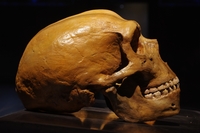In the same section
-
Share this page
Research project "NEANDERTHAL-3D" (BRAIN-be program)
Researchers will focus on how to showcase the reconstructed Spy II Neanderthal, one of the skeletons discovered in the Spy cave and one of the most complete Neanderthal skeletons available.

The ‘NEANDERTHAL-3D’ project aims to highlight Belgian scientific and cultural heritage as well the current state of the art research in Paleoanthropology. The project will evaluate how to make accessible the existing digital collection of over 300 Neanderthal and human specimens which are housed at Royal Belgian Institute of Natural Sciences. It will also focus on how to showcase the reconstructed Spy II Neanderthal, one of the skeletons discovered in the Spy cave and one of the most complete Neanderthal skeletons available.
The role of the Laboratory of Anatomy, Biomechanics and Organogenesis (LABO, Faculty of Medicine) in this project is to improve digital data and models. Researchers will develop improved methods that better represent muscle behavior within modelling work. The following improvement of lhpFusionBox, the lab’ scientific software, will allow measurements to be taken more easily and also improve the biomechanical analysis and morphological comparison of different specimens.
NEANDERTHAL-3D is coordinated by Serge Van Sint Jan (Laboratory of Anatomy, Biomechanics and Organogenesis, Faculty of Medicine, ULB), and includes the Royal Belgian Institute of Natural Sciences, the VUB and the Association pour la Diffusion de l’Information Archéologique (ADIA).
End of the project: 15/01/2019
